
Since August 1945
Phu Gia village is an ancient village, formed from the end of the Le dynasty, the beginning of the Nguyen dynasty. After many changes in the land administration, Phu Gia village belongs to Phu Thuong commune, now Phu Thuong ward, Hanoi city. The village is located next to the Red River, so it has the opportunity to participate in a special historical event of the country and the nation.
In late August 1945, the Red River also rose, rolling in alluvium, flooding the mulberry fields on the beach. A boat drifted from upstream, gently docking at the beach leading to Phu Gia village when it was already dark.
Then a group of people quietly left the boat, moving discreetly and secretly into the village. The group stopped in front of a house, pushed open the low wooden gate, walked through a square, spacious brick yard and entered a 5-room brick house, with 4 embossed words on the porch: Clear moon, cool breeze.
That was the house of Mr. Cong Ngoc Lam and Mrs. Nguyen Thi An. Later, Mrs. Cong Thi Thu - the daughter of Mr. Lam and Mrs. An, who was only 17 years old at that time, recalled: "That day was August 23, comrade Hoang Tung, Chairman of the People's Revolutionary Committee, came to the house to announce that the family was preparing to welcome a group of guests from the war zone back to Hanoi."
At that time, although the August Revolution had broken out, in the Phu Thuong area, the posts of the puppet militia working for the French colonialists and Japanese fascists were still located on the main traffic routes leading to Hanoi, so the task of keeping the "high-level war zone" secret was given top priority.
Upon receiving the notice from Comrade Hoang Tung, Mr. Lam and Mrs. An's family hurriedly cleaned up the house to welcome the guests. At around 6 p.m., Comrade Hoang Tung led a group of high-ranking officials to arrive, a total of 12 people, dressed in mountain-style clothing and carrying weapons.
In the group, there was an old man with a long beard, bright eyes, and a thin figure, but his gait and movements were very agile and lively. Although he wore mountain clothes, he spoke with a gentle, warm central accent. Because the group had prepared dinner, comrade Hoang Tung only asked Mrs. Thu and her children to cook a pot of porridge for a late night snack after work.
Mrs. An immediately ordered her daughter to kill a chicken and cook porridge. When the porridge was cooked, she brought the tray of porridge up to invite the group. The old man and everyone else accepted the porridge without any formality and ate it. The old man praised the porridge for being delicious and thanked the family for their thoughtful hospitality.
Mrs. Thu continued: “The next day, my mother thought that the old man needed nourishment, so she often cooked different dishes to change his taste. Knowing that he liked to eat vegetables, my mother and I cooked rustic plain soups such as taro soup, banana soup, and bean soup for each meal.
Apparently, the dishes were all to his taste, so the old man and the high-ranking delegation of the war zone ate very well. I remember that the old man worked continuously, sometimes working hard on the typewriter, sometimes in group meetings, sleeping very little, but his health seemed to be improving.
The delegation rested and worked at Mrs. An’s house from August 23 to 25. On the afternoon of the 25th, two black cars brought the cadres to the house, met the old man and sat on the sofa to work. They were comrades Truong Chinh, Nguyen Luong Bang, Vo Nguyen Giap and Tran Dang Ninh.
The meeting ended around 5pm, the old man called Mrs. An and said he would be moving into the city to work urgently, and at the same time sent his thanks and farewell to the whole family for welcoming the delegation. He also promised to come back to visit the family when it was convenient.
On September 2, Hanoians flocked to Ba Dinh Square to attend the rally and listen to President Ho Chi Minh read the Declaration of Independence, giving birth to the Democratic Republic of Vietnam. Early in the morning, Ms. Thu, a member of the National Salvation Youth Union, accompanied the delegation of the local government and people to Ba Dinh Square.
When the procession appeared on the stage, she was startled to see an old man standing near the microphone who looked very similar to the old man who had come to her house a few days before, except that today he was wearing a light-colored cloth suit. When the old man spoke and read the Declaration of Independence, Mrs. Thu knew for sure that it was the old man who lived in her house and that was President Ho Chi Minh.
After the rally, Mrs. Thu ran home to tell her parents the good news. The whole family was filled with tears of joy, because they never expected that their house would be the place to welcome President Ho Chi Minh and cook for him during the days of preparation for the Declaration of Independence.
Since then, every National Day, Mrs. Thu's family, Phu Gia villagers and many families across Vietnam prepare a meal to celebrate Independence Day.
… To the Independence Day meal in 2025
80 years have passed, the Independence Day meal has become familiar to families in Hanoi in particular and Vietnam in general. That meal not only marks the most important historical event of the nation becoming citizens of an independent Vietnam, but also commemorates the merits of President Ho Chi Minh, who passed away forever on September 2, 1969.
Vietnamese people inherently “food comes first”, so big holidays and important events are always associated with eating and drinking. Thanks to the feast, everyone can gather around a square or circle, which symbolizes the earth or sky, to share sweet, savory, fragrant and herbal pieces.
Tet meals are not only about the sumptuous dishes and delicious food, but also the precious occasion of sharing sincere meals and the opportunity to shake hands and smile with tears in our eyes. National Day has become a new Tet holiday of the nation since 1945, the Independence Day, so no tray of food can be absent.
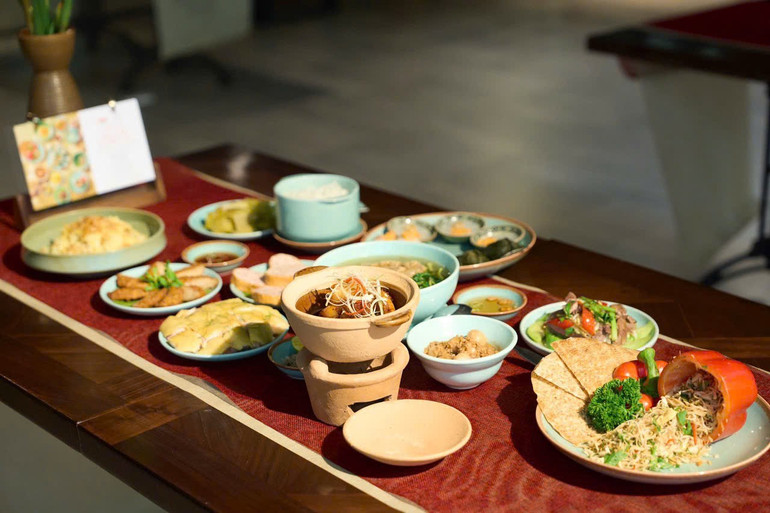
This is a feast to celebrate and remind each other of a moment of pride in being Vietnamese of an independent Vietnam. After 8 decades, the feast to celebrate Independence Day has become a custom and tradition. Therefore, on the occasion of National Day 2025, Hanoi women still follow tradition to prepare a meaningful Independence feast.
That meal cannot lack luxury, neatness, and sophistication, but it must also express the spirit of Vietnamese cuisine, especially the places and dishes related to this historical event of the founding of the nation such as Nghe An, Hanoi, Phu Thuong and the quintessence representing the three regions of North, Central and South.
With that common concern, Hanoi women who are proficient in cooking and cuisine such as journalist Vinh Quyen and businesswoman Pham Thi Bich Hanh - owner of Ngon Garden restaurant - a restaurant that has been listed on the Michelin Selected list in Hanoi three times - have prepared an Independence Day meal together to treat distinguished guests coming to Hanoi on the occasion of National Day on September 2 this year.
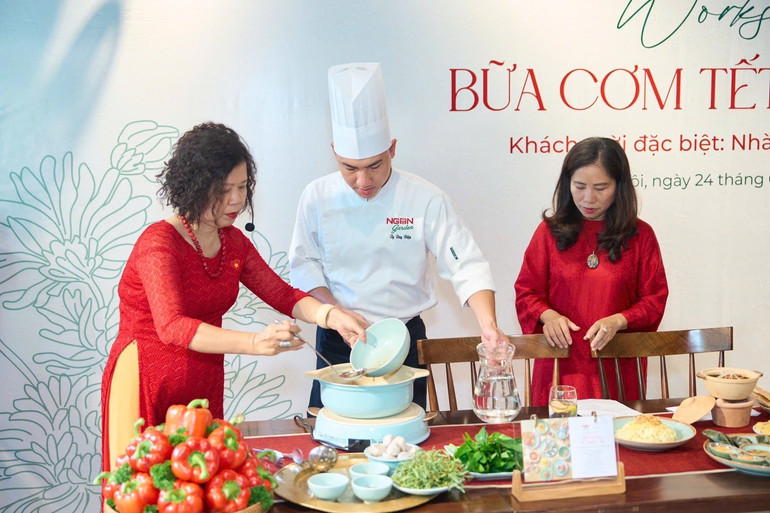
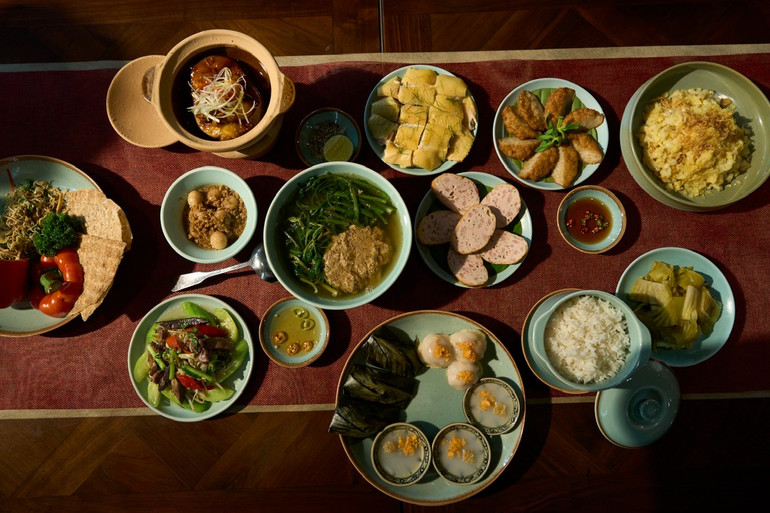
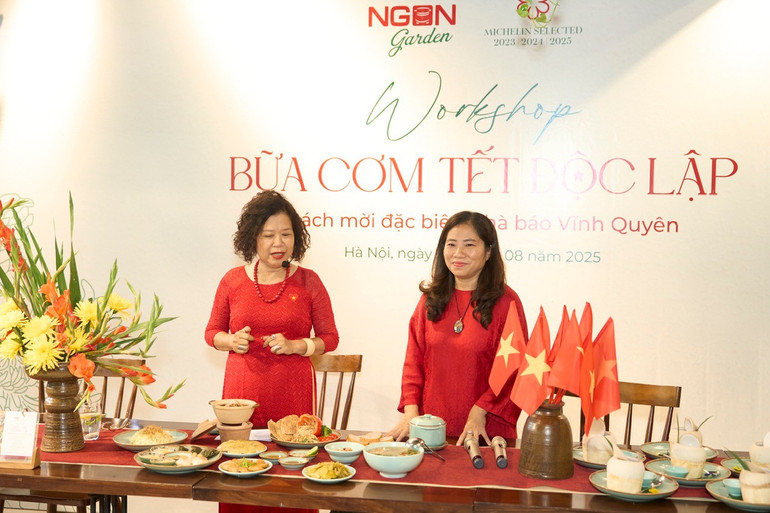
The Independence Day meal includes 10 dishes: Thanh Chuong pickled mustard green salad, stir-fried squash with chicken gizzards, steamed chicken with lemon leaves, Hanoi green rice sausage, Phu Thuong corn sticky rice, Hue rice cake, Nam Dan eggplant with soy sauce, braised snakehead fish in clay pot, crab soup with taro and water spinach, and lotus seed sweet soup with longan and coconut for dessert.
Just looking at the tray of food, diners can clearly see the purpose of honoring the National Day of September 2nd, along with the characters and regions closely related to this event, while also expressing the spirit of reunion and solidarity of the North-Central-South, the country and rivers united around a tray of food, throughout the dishes, from appetizers to desserts.
There are culinary flavors from the hometown of Sen village of the “superior old man” - President Ho Chi Minh, with dishes such as Thanh Chuong pickled mustard greens and Nam Dan eggplant. The pickled mustard greens salad in the Nghe An proverb “Thanh Chuong pickled mustard greens, Nam Dan soy sauce” is a familiar dish of Nghe An people, especially during the harvest season.
Young jackfruit is sliced into small pieces, salted and eaten with rice to create a dish called nhut, and now it is a specialty of Thanh Chuong. On this Independence Day meal, Thanh Chuong nhut is transformed into a very interesting and delicate dish called "goi nhut", creating a memorable delicacy.
The Nam Dan eggplant bowl will be combined with a bowl of crab soup with water spinach, water mimosa and taro, which was cooked by Mrs. An 80 years ago to treat the “high-class old man”. Crab soup, eggplant eaten with white rice is a culinary symbol of the Northern Delta and North Central regions. The additional savory dish here is braised snakehead fish in a clay pot, a dish typical of Western cuisine.
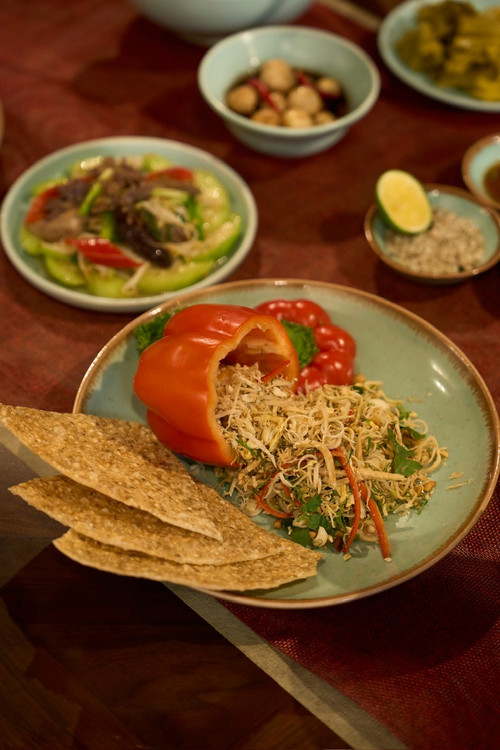
The sign of the land that welcomed the delegation of high-ranking officials to the capital to prepare for the National Day on September 2, 1945 is Phu Thuong corn sticky rice. The village where Mr. Lam and Mrs. An's house is located has long been famous for its traditional craft of making sticky, fragrant, plump, and juicy sticky rice.
The reputation of Phu Thuong sticky rice has spread far and wide, and by February 2024, the Phu Thuong sticky rice craft was listed as a National Intangible Cultural Heritage. Currently, in the village where Uncle Ho set foot in the past, there are still more than 600 households following the traditional craft of making sticky rice.
In addition to the Phu Thuong sticky rice dish bearing the clear imprint of the place, the meal also has a unique Hanoi green rice sausage dish, well-deservedly famous, and imbued with the culinary spirit of Hanoians. Because green rice is available everywhere, but the intention to turn that green rice into a noble, sophisticated sausage is only found in Hanoians.
Therefore, cốm sausage deserves to represent Hanoi cuisine in the Independence Day meal. Cốm sausage has a crispy outer shell, and inside are soft cốm grains mixed with minced meat. Cốm sausage has the sweetness of meat, the richness of fat and the chewiness and richness of fresh cốm.
Hanoi green rice sausage is chewy and sweet. The chewy texture symbolizes unity, and the sweet, nutty taste doesn’t mean “the sweet taste reminds me of the bitterness” of the days before national independence. And furthermore, the best season for green rice in Hanoi is in the fall, when the rice is just starting to ripen, spreading the fragrance of green rice in the wind of the Independence autumn.
Just like that, each dish on the Independence Day meal tray carries subtle layers of meaning. Braised catfish in a clay pot is the flavor of the cuisine of the Mekong Delta, banh it with shrimp and pork filling from Hue is both beautiful and stylish, banh la carries the rustic flavor of the central region's character.
The Independence Day meal ends with a coconut sweet soup, a fruit from the South, cooked with Hung Yen longan, Tinh Tam lake lotus seeds (Hue), Duc Pho rock sugar (Quang Ngai) following the Hanoian style of making sweet soup to become a beautiful, delicious, light, sweet dessert that carries the spirit of "joining hands together".
There are clear layers of meaning, there are layers of meaning that are only embellished, but those who enjoy the Independence Day meal all understand and feel it. Because in the end, that is the meaning of compatriots gathering around the meal to celebrate Independence Day, to celebrate the 80th National Day of the Socialist Republic of Vietnam!
Source: https://nhandan.vn/80-nam-mam-com-mung-tet-doc-lap-post905136.html



![[Photo] Ho Chi Minh City is filled with flags and flowers on the eve of National Day September 2](https://vphoto.vietnam.vn/thumb/1200x675/vietnam/resource/IMAGE/2025/9/1/f493a66401844d4c90919b65741ec639)
![[Photo] President Luong Cuong receives Chairman of the House of Representatives (Lower House) of the Republic of Belarus Igor Sergeyenko](https://vphoto.vietnam.vn/thumb/1200x675/vietnam/resource/IMAGE/2025/9/1/a67d61e41405410999a43db45a0ba29c)
![[Photo] General Secretary To Lam presides over the welcoming ceremony for First Secretary and President of Cuba Miguel Diaz-Canel Bermudez](https://vphoto.vietnam.vn/thumb/1200x675/vietnam/resource/IMAGE/2025/9/1/4f6ef5136b90463db3ebdd3d3d83ebe4)

![[Photo] Chairman of the National People's Congress of China Zhao Leji visits the Ho Chi Minh Mausoleum](https://vphoto.vietnam.vn/thumb/1200x675/vietnam/resource/IMAGE/2025/9/1/45b2a2744fa84d27a59515b2fe53b42a)
![[Photo] General Secretary To Lam holds talks with First Secretary and President of the Republic of Cuba Miguel Diaz-Canel Bermudez](https://vphoto.vietnam.vn/thumb/1200x675/vietnam/resource/IMAGE/2025/9/1/a2eab2ee4e4a4a81a8c605e46055ab78)













![[Photo] Celebration of the 65th Anniversary of the Establishment of Diplomatic Relations between Vietnam and Cuba](https://vphoto.vietnam.vn/thumb/402x226/vietnam/resource/IMAGE/2025/9/1/0ed159f3f19344e497ab652956b15cca)








































































Comment (0)